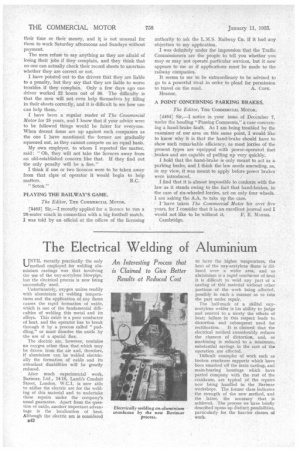The Electrical Welding of Aluminium
Page 60

If you've noticed an error in this article please click here to report it so we can fix it.
UNTIL recently practically the only 'kJ method employed for welding aluminium castings was that involving the use of the oxy-acetylene blowpipe, but the electrical process is now being successfully used.
Unfortunately, oxygen unites readily with aluminium at welding temperatures and the application of any flame causes the rapid formation of oxide, which is one of the fundamental difficulties of welding this metal and its alloys. This oxide is a poor conductor of heat, and the operator has to break through it by a process called "puddling," or must dissolve the oxide by the use of a special flux.
The electric arc, however, contains no oxygen other than that which may be drawn from the air and, therefore, if aluminium can be welded electrically the formation of oxide and its attendant disabilities will be greatly reduced.
• After much experimental work, Barimar, Ltd., 14-18, Lamb's Conduit Street, London, W.C.1, is now able to utilize the electric arc for the welding of this material and to undertake these repairs under the company's usual guarantee. Apart from the question of oxide, another important advantage is the localization of heat. Although the electric arc is considered
£42
to have the higher temperature, the heat of the oxy-acetylene flame is diffused over a wider area, and as aluminium is a rapid conductor of heat it is difficult to weld any part of a casting of this material Without other portions of the work being affected, possibly in such a manner as to ruin the part under repair.
The hall-mark of a skilful oxyacetylene welder is his ability to judge and control to a nicety the effects of heat; failure in this respect leads to distortion and subsequent need for
rectification. It is claimed that the electrical method considerably reduces the chances of distortion, and, as machining is reduced to a minimum, substantial savings in the cost of the operation are effected.
Difficult examples of work such as broken crankcase supports which have been smashed off the main casting, and main-hearing housings which have parted company with the rest of the crankcase, are typical of the repairs now being handled in the Barimar workshops. The former class indicates the strength of the new method, and the latter, the accuracy that is achieved. The process we have briefly described opens up distinct possibilities, particularly for the heavier classes of work.




































































































